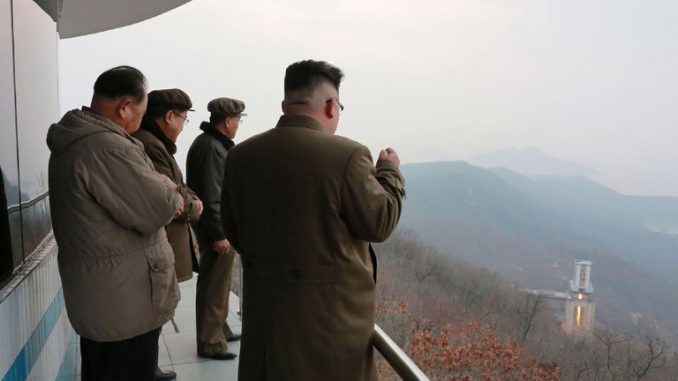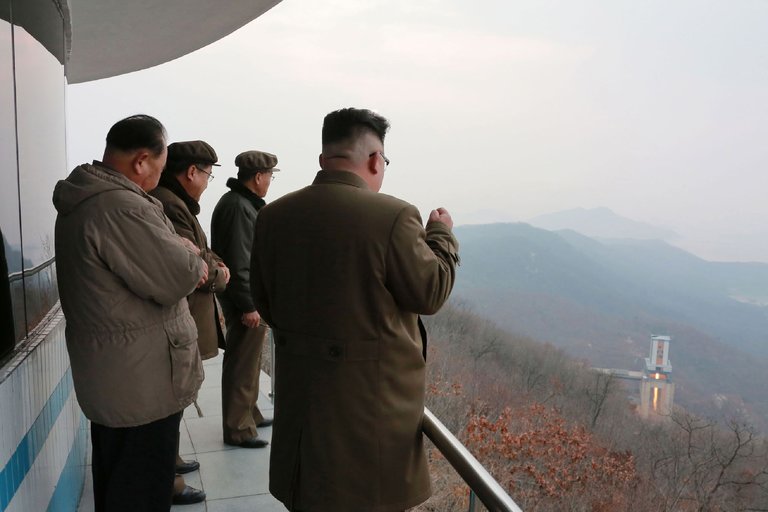
Test of the rocket engine took place at the Sohae Satellite Launching Ground in Tongchang-ri, in northwestern North Korea, where the country fired a carrier rocket in February 2016 to place its Kwangmyongsong, or Shining Star, satellite into orbit. After that launch, South Korean defense officials said that the Unha rocket used in the launch, if successfully reconfigured as a missile, could fly more than 7,400 miles with a warhead of 1,100 to 1,300 pounds — far enough to reach most of the US. Here, Kim Jong-un, the leader of North Korea, is seen inspecting the test of the newly developed high-thrust engine, in a photograph released by the North’s official news agency.
North Korea’s latest test of a rocket engine showed that the country was making “meaningful progress” in trying to build more powerful rockets and missiles,
South Korean officials said following the late March event.
North Korea said it had conducted a ground jet test of a newly developed high-thrust missile engine,
which its leader, Kim Jong-un, called “a great event of historic significance.”
Using the characteristic bombast of such announcements, he said that the test heralded “a new birth” of the country’s rocket industry
and that “the whole world will soon witness what eventful significance the great victory won today carries.”
The North’s rival, South Korea, acknowledged the day after the test represented a breakthrough.
Lee Jin-woo, a spokesman at the Defense Ministry, said it showed that the North was developing a more sophisticated rocket engine.
The model that the North tested included a cluster consisting of a main engine and four vernier thrusters —
smaller engines used to adjust the craft’s velocity and stability.
“Through this test, it is found that engine function has made meaningful progress,” Lee said during a news briefing, without divulging further details.
He declined to say whether the engine was for a rocket used to place a satellite into orbit
or for an intercontinental ballistic missile, or ICBM, which the North has been threatening to test-flight any time.
Lee said more analysis was needed to answer that question.
Kim has called for his country to develop and launch “a variety of more working satellites” using “carrier rockets of bigger capacity.”
The country has renovated and expanded the gantry tower and other facilities at the launch site to accommodate more powerful rockets.
The United Nations Security Council has banned the country from satellite launchings,
considering its satellite program a cover for developing an intercontinental ballistic missile.
The test of the rocket engine took place at the Sohae Satellite Launching Ground in Tongchang-ri, in northwestern North Korea,
where the country fired a carrier rocket in February 2016 to place its Kwangmyongsong, or Shining Star, satellite into orbit.
After that launch, South Korean defense officials said that the Unha rocket used in the launch,
if successfully reconfigured as a missile, could fly more than 7,400 miles with a warhead of 1,100 to 1,300 pounds —
far enough to reach most of the US.
In September, North Korea conducted the ground test of what it called a new long-range rocket engine in Tongchang-ri, days after it conducted its fifth underground nuclear test.
Although the North has never test-flown an ICBM, it has recently demonstrated significant progress in its missile programs.
In February, it launched a new type of intermediate-range ballistic missile that it said could carry a nuclear payload.
That missile, the Pukguksong-2, uses a solid-fuel technology that US experts say will make it easier for the country to hide its arsenal in its numerous tunnels and deploy its missiles.
Since Kim took power in 2011, North Korea has launched 46 ballistic missiles, including 24 last year,
violating resolutions by the United Nations Security Council that ban the country from developing or testing such weapons, according to South Korean officials.
In his New Year’s Day speech, Kim said his country was in the “final stage” of preparing for its first ICBM test.
Source: North Korea’s Test of Rocket Engine Shows ‘Meaningful Progress,’ South Says – The New York Times
